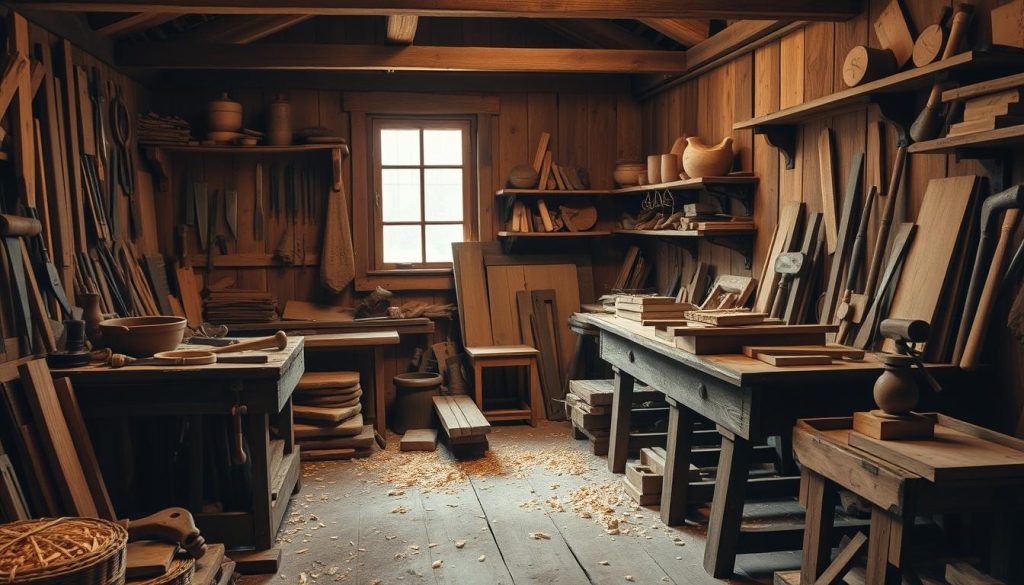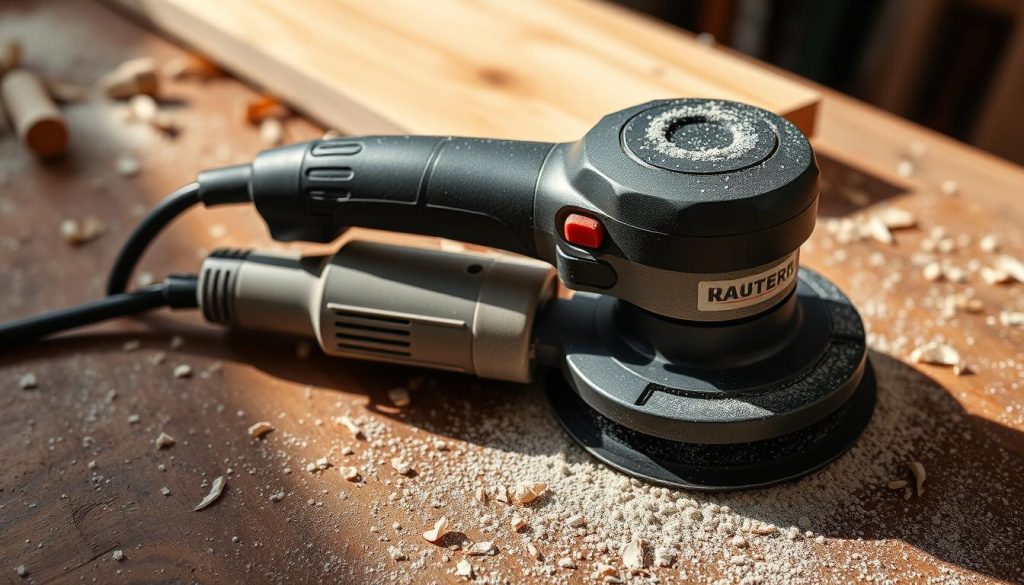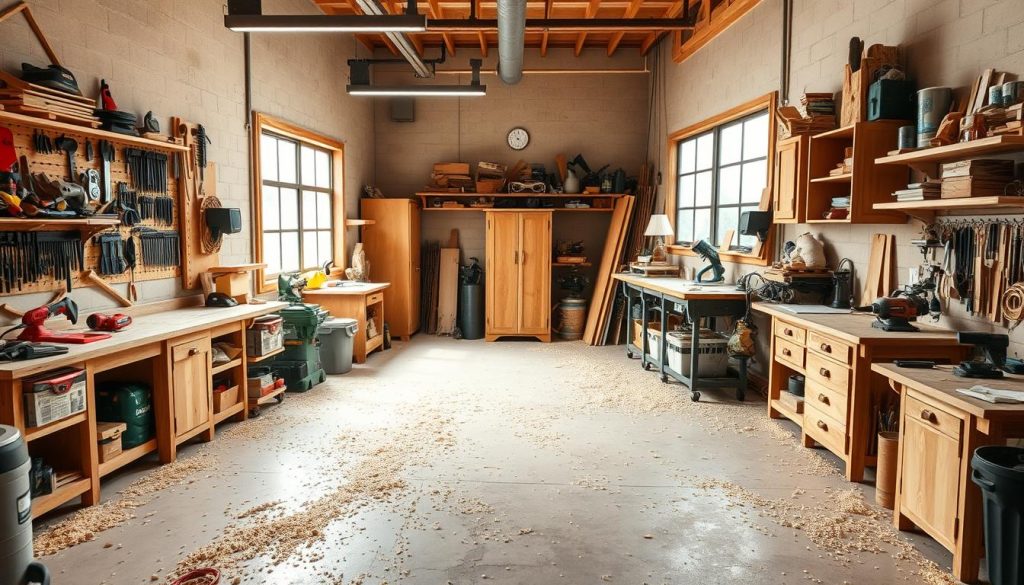Setting up your workshop with the right tools is key to making amazing projects. You’ll need everything from basic hand tools to advanced power tools. This guide will show you the top 10 tools every workshop needs. They’ll help you work efficiently and with high quality.
Whether you’re an experienced woodworker or just starting, knowing your tools is important. Tools like the table saw and router are essential. So are chisels and orbital sanders. Each tool helps turn wood into something beautiful and useful.

Key Takeaways
- Discover the top 10 essential woodworking tools for your workshop
- Understand the unique applications and benefits of each tool
- Learn how to create stunning projects by leveraging the right equipment
- Explore top woodworking brands and their high-quality tool offerings
- Discover how to expand your tool collection with specialized equipment
Understanding Basic Woodworking Tools
Woodworking needs a variety of tools, both hand and power tools. Each has its own role. Knowing the difference between them is important for anyone starting in woodworking.
Difference Between Hand Tools and Power Tools
Hand tools, like chisels and saws, need you to do the work. They are precise and versatile. Power tools, which use electricity, are faster but need safety care.
Safety Considerations for Tool Usage
Safety is always first when using tools. Wear safety glasses, gloves, and ear protection. Use tools right and follow the maker’s rules to avoid accidents.
Tool Maintenance Basics
Keeping tools in good shape is vital. Clean, sharpen, and oil them regularly. Storing and handling tools right also helps them last longer. Taking care of your tools means they’ll work well for you for a long time.
Table Saw: The Heart of Your Workshop
The table saw is the most important tool in any woodworking shop. It’s fast, precise, and versatile for many cuts like rip, crosscuts, and dado cuts. Knowing how to use a table saw is key for top-notch results, whether you’re experienced or new.
Choosing the right table saw involves looking at power, fence quality, and safety features. The SawStop table saw is a great choice for its safety. It can stop the blade in under 5 milliseconds if it touches skin.
Safe and accurate cuts depend on proper table saw use and care. It’s important to understand the risks, like kickback, to avoid accidents. Jigs, fixtures, and outfeed tables can also make your table saw safer and more versatile.
With the right table saw and knowledge, woodworkers can handle many projects. From ripping boards to making precise dado cuts, mastering this tool opens up new possibilities. It can take your woodworking to new levels.
Essential Power Tools for Every Woodworker
Having the right power tools is key for woodworkers. The circular saw, drill, and router are must-haves. They improve project quality and efficiency.
Circular Saws and Their Applications
A circular saw is great for many tasks. It cuts wood straight and trims materials. Look for adjustable depth and bevel settings and a strong motor.
Cordless saws are handy for moving around. But corded ones give more power for big jobs.
Drill Selection Guide
A good drill is crucial for woodworking. Choose one with different speeds and can move in both directions. Cordless drills are flexible, while corded ones are more powerful.
Think about the drill’s size, weight, battery life, and charging time. This helps find the perfect one for you.
Router Fundamentals
Routers are vital for woodworking. They cut edges, trim, and make joints. Look for a powerful motor, variable speed, and bit compatibility.
Cordless routers are great for moving around. But corded ones are better for big tasks.
Investing in quality circular saws, drills, and routers boosts your woodworking skills. You’ll make stunning projects with ease and precision.
Bandsaw Selection and Usage
The bandsaw is a key tool in woodworking. It’s great for making curves, resawing lumber, and creating veneers. Choosing the right bandsaw is important. Look at throat capacity, motor power, and blade guides.
A 14-inch bandsaw with a sub-2 HP motor works well for small tasks. But, for bigger projects, a 17-inch bandsaw with at least 1.75 HP is better.
Brands like Jet, Laguna, and Rikon make quality bandsaws. The Grizzly G0513ANV, a 17-inch 2 HP model, won a “Best of Value” award. Highland Woodworking’s Wood Slicer® Resaw Bandsaw Blade is known for fast resawing and clean cuts.
Setting up and maintaining your bandsaw is key. Make sure the blade is aligned, wheels are balanced, and guides are adjusted right. A well-maintained bandsaw will last longer and work better.
Key Considerations for Bandsaw Selection
- Throat capacity: Determines the maximum width of material you can cut
- Motor power: More power (1.75 HP or higher) for substantial resawing tasks
- Blade guides: Ensure precise and smooth blade tracking
- Reputable brands: Jet, Laguna, Rikon, Grizzly, and Powermatic offer quality options
Bandsaw Blades and Accessories
- Resaw blades: The Highland Woodworking’s Wood Slicer® Resaw Bandsaw Blade is a top performer
- Blade width: 1/8-inch to 1/4-inch with 4 tpi for cutting tight curves
- Blade types: Carbide-tipped blades for 14-inch bandsaws, though 18-inch models are preferable for extensive resawing
Hand Tools Every Workshop Needs
Woodworking is all about the right tools. Chisels, measuring tools, and hand planes are key. They are the heart of any workshop. Let’s look at the essential tools every woodworker needs.
Choosing the Right Chisels
Chisels are vital for shaping wood. Choose high-quality ones that feel good in your hand. Start with a set of bench chisels from 1/4-inch to 1-inch wide.
Make sure they have sharp, durable edges. This ensures your work is precise and lasts longer.
Essential Measuring Tools
- Tape Measure: A reliable and versatile tool for measuring lengths and distances.
- Squares: Both combination squares and framing squares are essential for marking, measuring, and checking angles.
- Calipers: Digital or vernier calipers provide precise measurements for small parts and intricate details.
Hand Planes Guide
Hand planes are crucial for smoothing wood. You’ll need a jack plane for rough work, a low-angle block plane for fine details, and a jointer plane for straightening. Choose quality and comfort when picking hand planes.
Getting the right tools is key for woodworkers. Whether you’re a pro or a hobbyist, the right chisels, measuring tools, and hand planes are essential. They help you tackle any woodworking project with confidence and precision.
Orbital Sanders and Surface Preparation
Orbital sanders are key for preparing and finishing wood projects. They sand in a circular motion, making them easy to handle. When picking an orbital sander, think about size, power, and dust collection.
Bosch offers affordable orbital sanders. Festool, on the other hand, has top-notch sanders with great dust collection. Random orbit sanders spin fast, while right-angle drive sanders are slower, perfect for big surfaces.
Getting a smooth finish needs the right sanding techniques. Start with coarse grit on flat surfaces, moving the sander in different directions. Then, switch to finer grits and sand with the grain. Good dust collection is vital for a clean workspace.
- Random orbit sanders operate at 10,000–13,000 orbits per minute, making them efficient for woodworking projects.
- Right-angle drive sanders run at slower speeds of around 5,000 orbits per minute, suitable for larger surfaces like cabinets and tabletops.
- In-line drive sanders offer a balanced approach, combining the power of right-angle sanders with more controllability.
- Sandpaper discs come in various grits, from coarse for rapid material removal to very fine for finishing work.
- Effective dust collection systems in sanders are crucial for health and clean work environments.

Using orbital sanders safely is important. Always let the sander stop before putting it down. Make sure you have good air flow to avoid breathing in dust. Check the tool and accessories often for damage. By knowing how to use orbital sanders, woodworkers can get perfect finishes.
Dust Collection Systems and Workshop Safety
Keeping your workshop clean and safe is key for woodworkers. Dust collection systems are essential for this. They help control dust in the air and improve air quality. The right dust collection system can lower health risks and make your tools last longer.
Types of Dust Collectors
There are many dust collection systems to choose from. Single-stage dust collectors are great for small workshops, catching big particles well. Two-stage collectors filter finer dust, while cyclone separators excel at separating dust from air.
Setting Up Proper Ventilation
- Make sure your dust collector has enough CFM to clear your workspace of dust.
- Look for dust collectors with high filtration efficiency to catch smaller particles.
- Place your dust collection equipment and ductwork to improve airflow and system performance.
- Keep your dust collection system in top shape by cleaning filters and checking ductwork regularly.
Good ventilation is vital for workshop safety. A well-designed ventilation system keeps your workspace clean and healthy. This reduces the chance of respiratory problems and damage to your equipment from dust.
Jointers and Planers: Creating Perfect Surfaces
In woodworking, jointers and planers are key for making flat, square, and smooth surfaces. Jointers mainly flatten one face and square one edge of a board. Planers, on the other hand, make sure the wood is the same thickness all over.
When picking a jointer or planer, look at the cutting width, motor power, and bed length. Spiral or helical cutterheads are better than straight knives. They give a smoother finish and are quieter.
- Jointers are great for making surfaces smooth and edges square for glue joints.
- Planers are essential for making all boards the same thickness, ensuring they’re the same size.
- Keeping blades sharp is important for both jointers and planers to get clean cuts and precise results.
Choosing between a jointer and a planer depends on what you need. Jointers are best for smoothing and squaring edges. Planers are better for making sure all boards are the same thickness and look polished. Some people choose a combo jointer/planer to save space. But, it’s up to you based on how much space you have, your budget, and what you like.
Jointers and planers work together well in fine woodworking. Using both tools helps woodworkers make flat, straight, and even boards for their projects.
Miter Saws for Precise Cuts
A miter saw is key for woodworking, making accurate angled cuts. They’re great for precise trims, moldings, and frames. There are two main types: simple miter saws and compound miter saws.
Compound vs. Simple Miter Cuts
A simple miter saw makes angled cuts across a board’s width. But, a compound miter saw can do both miter and bevel cuts. Bevel cuts are angled along the board’s thickness. Compound miter saws offer more versatility for complex cuts.
Calibration and Maintenance
Keeping your miter saw accurate is vital. Regularly calibrate it to ensure angles are right. This might mean adjusting fences, stops, and more. Also, keep the blade sharp and clean, and the parts well-lubricated.
When picking a miter saw, think about blade size, motor power, and cutting capacity. With the right care, a miter saw is a valuable tool. It lets you make precise cuts and angled cuts confidently.
Workshop Storage Solutions
Keeping your workshop organized is key for woodworkers. The right tool storage can boost your productivity. You have many options, like pegboards and tool cabinets, to improve your workshop’s layout.
Pegboards are a favorite for tool storage. They make it easy to see and reach your tools. Plus, you can customize them to fit your tools and space.
- Pegboards help keep your workshop tidy and organized.
- As you grow your skills and tools, a custom storage solution is essential. Pegboards are flexible and adaptable.
- Experts, like Richard from The English Woodworker, say quick access to tools is crucial for efficiency in small workshops.
Tool cabinets and chests are great for storing power tools and big equipment. They keep your tools safe from dust and moisture. They also offer a neat and easy-to-use storage system.
Good workshop organization is vital for staying productive, especially in small spaces. Using overhead storage, like air compressor lofts and ceiling drawers, can free up floor space. This keeps your work area clear and organized.
Setting up a solid tool storage system makes woodworking more fun and efficient. You can pick pegboards, tool cabinets, or a mix. The most important thing is to find a system that suits your needs and keeps you organized.
Tool Investment Strategy and Budgeting
Creating a smart tool investment plan is key to setting up a great woodworking workshop without spending too much. It’s important to find a balance between saving money and getting quality tools. This balance helps you make the most of your budget.
New vs. Used Tools
For big, pricey tools like table saws and bandsaws, used models can be a good deal. They often need repairs or adjustments, which can save you a lot of money. But, for tools you use a lot, like sanders and drills, it’s better to buy new. This way, you avoid problems that can come with used tools.
Quality vs. Price Considerations
- Invest in top-quality tools for your go-to tools, like your main saw or router. They offer better performance, precision, and last longer.
- For tools you don’t use as much, look for cheaper options that still work well. This helps you make your budget go further.
- Do your research to find the best value. Look at tool quality and prices to make sure you’re getting what you pay for.
By carefully planning your tool investment and balancing quality with cost, you can create a workshop. It will have all the tools you need for various woodworking projects without spending too much.
Setting Up Your Workspace Layout
Creating an efficient workshop layout is key to boosting productivity and keeping your space safe. Arranging your tools and workstations wisely helps streamline your woodworking projects. This makes your workflow better and your projects more efficient.
Begin by grouping tools and machines that go together. This cuts down on the distance you travel between tasks. For example, place your table saw, miter saw, and jointer near each other. This makes cutting and shaping easier.
It’s also important to have enough space between machines for safety and ease. Make sure there’s at least 3 feet between stationary power tools. This gives you room to move and lowers the chance of accidents. Adding rolling bases to your machines can also help adjust your layout as needed.
Good lighting is vital in a workshop. Try to use natural light or sunlight whenever you can. Paint walls and ceilings light colors to reflect more light. This improves visibility and makes your workspace more inviting and productive.
By planning your workshop layout carefully, you can make a smooth and efficient work area. Think about your workflow, tool placement, and safety. This ensures your workspace is great for both productivity and your well-being.

Conclusion
Creating a great woodworking workshop needs careful planning and the right woodworking tools. Start with basics like a table saw, drill, and sander. Then, add more tools as you get better and take on new projects. Always keep safety first, maintain your tools well, and store them properly.
The best tools fit your woodworking goals and budget. Whether you’re new or experienced, the right tool selection is key. With the right tools and setup, you’ll be ready for many woodworking projects.
Follow this article’s advice to build a workshop that meets your needs and supports your creativity. Enjoy the process of making your dream workshop. And take pride in creating beautiful, useful woodwork pieces.